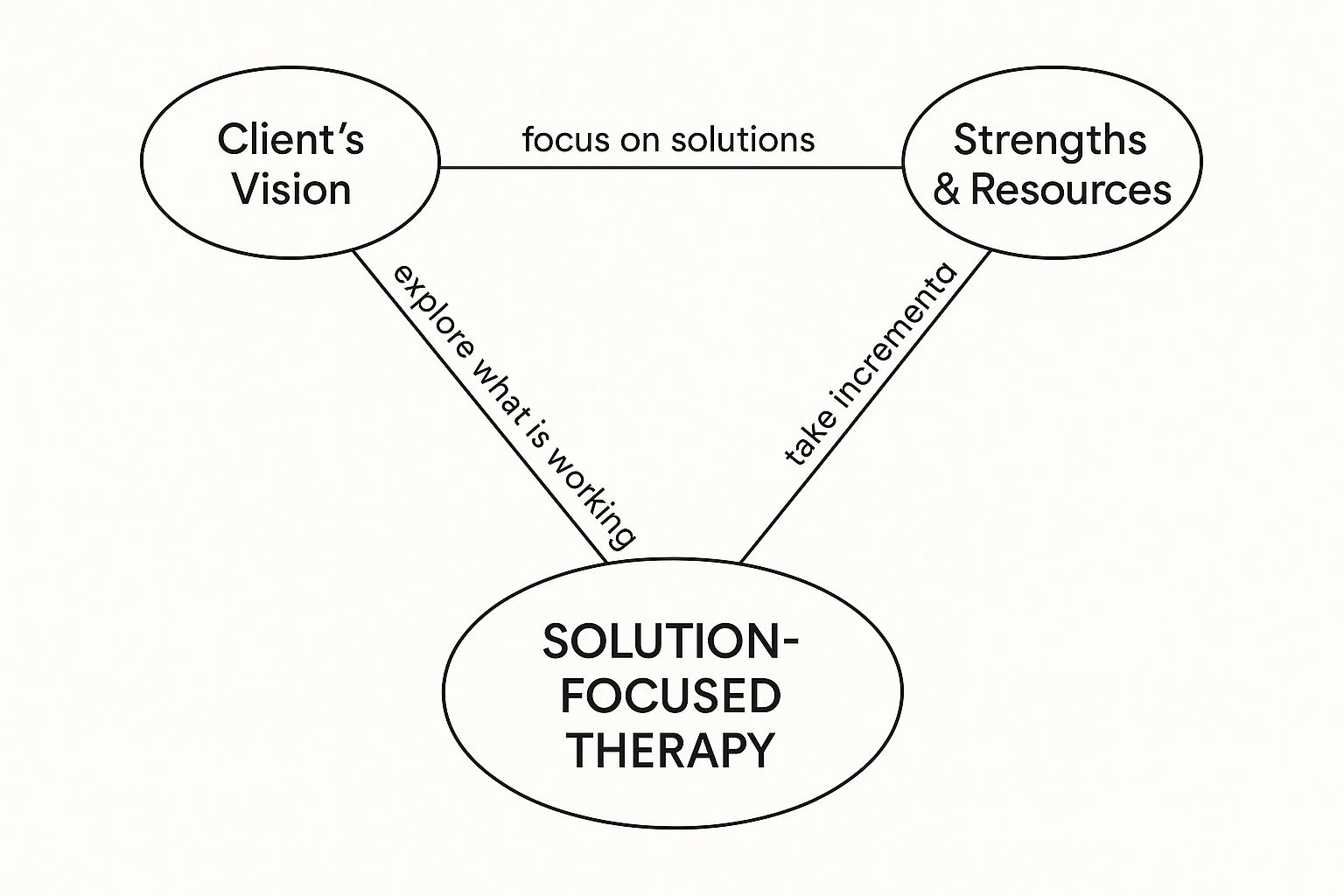
What is Solution Focused Therapy? Discover Its Benefits Today
Share
So, what actually is Solution Focused Therapy?
Let's get right to it. Solution Focused Therapy (SFT), sometimes known as Solution Focused Brief Therapy (SFBT), is a forward-looking, practical approach to therapy. It concentrates on what you want to achieve rather than digging deep into the past problems that brought you here.
Imagine this: instead of spending hours analysing exactly why a ship sank, SFT is all about charting a course to a new, better island, using the crew and resources you already have on board.
The Solution Focused Way of Thinking
This therapy is all about empowering you. It shines a light on your existing strengths, skills, and past successes to help you build the future you want. It's a team effort between you and the therapist, and it's become incredibly popular across the UK, from NHS services to school counselling rooms, because it respects that you are the expert on your own life.
We'll look at how this shift in focus, from problems to possibilities, makes it such a uniquely powerful form of therapy.
Just a quick note: this article is for information only. I am not a mental health professional. If you have concerns about your own or your child's mental health, the first and most important step is always to speak with your GP. This guide is here to offer a bit of clarity and support on your journey.
From 'Problem Talk' to 'Possibility Talk'
The big difference with SFT is its deliberate move away from endlessly analysing the problem. Instead of a deep-dive into the 'why' behind a difficulty, a therapist will guide you to explore the 'how' of the future you'd prefer. This doesn't mean ignoring the problem; it just reframes the entire conversation to be more constructive and hopeful.
This approach can be a game-changer for children and young people. In the UK, where it's estimated that one in five children now has a probable mental health condition, future-focused chats can feel much more accessible and less scary than trying to dissect complex past events. With new pressures from things like social media, SFT offers a really practical way to build up resilience.
The visual below shows how the core parts of SFT work together, connecting your vision for the future with your current strengths to create real, actionable steps forward.

This map really highlights that the process isn't about pretending problems don't exist. It's about actively building solutions using what you've already got: your own vision and your own resources.
To make this distinction crystal clear, here’s a quick comparison of the two therapy mindsets.
Problem Focused vs Solution Focused Therapy At A Glance
| Focus Area | Problem-Focused Approach | Solution-Focused Approach |
|---|---|---|
| Main Goal | Understand the cause and nature of the problem. | Build a vision of a preferred future. |
| Time Orientation | Past-oriented; explores history and origins. | Future-oriented; focuses on what's next. |
| Conversation Focus | "Problem talk": What's wrong? Why is it happening? | "Solution talk": What do you want instead? |
| View of Client | The client has a deficit or pathology to be fixed. | The client is resourceful and has existing strengths. |
| Therapist's Role | An expert who diagnoses and treats the problem. | A collaborator who helps the client find solutions. |
| Typical Questions | "How long have you felt this way?" | "What would be happening if the problem was solved?" |
As you can see, the shift is profound. It moves the entire therapeutic process from one of archaeology (digging up the past) to one of architecture (designing the future).
A Proven and Efficient Method
Since it was developed back in the 1970s by Steve de Shazer and Insoo Kim Berg, Solution-Focused Brief Therapy has become a well-respected, evidence-based approach in the UK.
Research shows its effectiveness is right up there with well-known therapies like Cognitive Behavioural Therapy (CBT), but often in far fewer sessions—typically just three to five. This efficiency is a huge plus, especially within the high-demand world of the NHS, making quality mental health support more accessible to more people. You can find out more about the research behind SFT's effectiveness over at Cambridge University Press.
The Core Principles That Guide SFT
To really get to grips with solution focused therapy, you have to understand the philosophy behind it. It’s built on a few simple but powerful ideas that completely shift the conversation from what’s wrong to what’s possible. Think of them less as rigid rules and more as a mindset that shapes every single question and conversation in the therapy room.
This approach is incredibly relevant today, especially as mental health challenges become more visible. To put it in perspective, poor mental health costs UK businesses an estimated £56 billion a year in absenteeism and lost productivity. SFT offers a practical, forward-looking way to build the resilience we all need.

If It Isn’t Broken, Don’t Fix It
It sounds almost too obvious, doesn't it? Yet, this is a foundational idea in SFT. It encourages us to look for the parts of our lives that are already working well. Instead of pouring all our energy into a problem, a therapist helps identify and amplify the things that are already going right.
For a child struggling with confidence at school, a therapist might ask, "Tell me about a time this week, even for a moment, when you felt a little bit more confident." This steers the conversation towards their successes—no matter how small—and starts building a foundation of strength.
Finding Exceptions to The Problem
Every problem has exceptions. These are the moments when the problem could have happened but, for whatever reason, it didn't. SFT is all about becoming a detective for these exceptions. They are crucial clues that point to your hidden strengths and resources.
Imagine a young person feeling overwhelmed by the pressures of social media. An exception question might be, "When was the last time you were online and didn’t feel anxious? What was different about that moment?"
By focusing on exceptions, you start to see that the problem doesn't control every aspect of your life. It highlights your capacity to cope and provides a blueprint for what to do more of.
This principle is vital. It shifts the narrative from "I always feel this way" to "Sometimes I don't," which is an incredibly empowering realisation. Understanding these moments of resilience is a key step towards building a better future, and this strength-based approach shares common ground with other supportive methods. If you're interested, you can learn more about how a focus on safety and empowerment is used in trauma-informed care in our detailed guide.
Change Is Constant and Inevitable
SFT works on the optimistic belief that change is always happening. Nothing stays the same forever. This simple truth helps create an expectation of positive change right from the start of therapy.
A therapist’s role is to help you notice and direct the small changes that are already occurring. The core beliefs of SFT really boil down to this:
- You are the expert: You know your life and your goals best. The therapist is a collaborator, not a director.
- Small steps lead to big changes: The focus is on finding the next small, manageable action rather than trying to solve everything at once.
- The future is created: The past doesn’t have to dictate what comes next. You have the power to build the outcome you want.
These principles come together to make SFT a hopeful and down-to-earth approach. By focusing on what works, identifying your strengths through exceptions, and embracing the idea that change is always possible, you become the architect of your own solutions. This is a huge reason for its growing use within modern UK healthcare and schools.
Powerful SFT Techniques in Action
So, how does solution focused therapy move from big ideas to real, practical change? It all comes down to a set of powerful, yet surprisingly simple, questioning techniques. These aren't just random questions; they're carefully crafted tools designed to shift your perspective, uncover strengths you didn't know you had, and build a tangible blueprint for a better future.
These methods help make the whole process feel less like a mysterious therapy session and more like a collaborative project.

This hands-on, goal-focused approach is a big reason why SFT has become so popular here in the UK. Solution-Focused Brief Therapy (SFBT) first landed on our shores in the 1980s with the pioneering BRIEF team, integrating it into British mental health services. As awareness around mental health grew, so did the need for accessible support; back in 2014, one in six adults in England reported having a common mental health disorder, with about a third seeking help. You can read more about the history and prevalence of these approaches in the UK.
The Miracle Question
This is probably one of the most famous SFT techniques out there, and for good reason. The Miracle Question is a clever way to bypass the "problem mindset" and jump straight into imagining what a solution actually looks like.
A therapist might ask: "Suppose that tonight, while you're asleep, a miracle happens and the problem that brought you here is completely solved. Because you were asleep, you don't know that a miracle has happened. When you wake up tomorrow morning, what will be the very first things you notice that will tell you things are different?"
This isn't about wishful thinking. It's about encouraging you to paint a detailed, concrete picture of your preferred future. That picture then becomes a clear, inspiring goal to start working towards.
Scaling Questions
When you're dealing with emotional challenges, progress can feel vague and hard to measure. Scaling Questions are fantastic because they make progress tangible by asking you to rate where you are on a simple scale.
For instance, a therapist might say: "On a scale of 1 to 10, where 1 is the worst this problem has ever been and 10 is the day after the miracle, where would you say you are today?"
Just putting a number on it provides a useful baseline. But the real magic is in the follow-up questions:
- "What have you already done to get yourself to a [current number] instead of a zero?" This immediately shines a light on your existing coping skills and successes.
- "What would a [current number + 1] look like? What's the first small sign you'd notice?" This breaks the next step down into a tiny, manageable, and observable action.
These questions empower you by showing you that you're not starting from scratch and that the very next step is well within your reach.
Exception-Finding Questions
No problem is all-powerful, all of the time. There are always moments when it's less intense, or even completely absent. Exception-Finding Questions are designed to hunt for these moments. These "exceptions" are goldmines because they reveal your natural resilience and what already works for you.
A therapist might ask a young person feeling overwhelmed by exam stress: "Can you tell me about a time in the last week when you felt even a tiny bit less stressed about your exams? What was different about that moment?"
By exploring these exceptions, you start to identify your own successful strategies. It shifts the entire conversation from what’s going wrong to what's already going right, giving you a clear path to simply do more of what works.
These techniques are brilliant for building self-esteem because they prove you already have the resources inside you to create change. For parents and educators looking for ways to support young people, you might also find our guide on practical worksheets for self-esteem helpful.
Together, these SFT tools transform conversations from being stuck in the problem to actively building a way forward.
Why SFT Works for Children and Young People
The mental health landscape for children and young people in the UK is facing some serious challenges. With pressures mounting from school, friendships, and the ever-present influence of social media, finding support that actually works is more vital than ever. This is where Solution Focused Therapy (SFT) offers a refreshing and hopeful alternative, shifting the conversation away from picking apart past problems to actively building a better future.
Children and teenagers often click with this forward-looking idea more easily than adults. Instead of asking them to analyse complicated past events they might not understand, SFT invites them to use their own imagination. It asks them to picture a future where their problems have shrunk or even disappeared completely. This simple shift empowers them to see themselves as capable and full of resources, helping to build resilience in a world that can feel pretty overwhelming at times.

This practical, strengths-based method has really taken hold within the UK education system, particularly among Educational Psychologists (EPs). A significant study way back in 2005 revealed that an incredible 97% of UK EPs surveyed were using SFT in their one-to-one work with pupils. This isn't just a passing trend; this widespread use shows how effective this therapy is seen to be for tackling social, emotional, and behavioural issues right where they often surface—at school. If you're interested in the details, you can explore the background of SFT's use in UK schools to learn more.
Making Progress Tangible for Young Minds
One of SFT's biggest wins with children is its ability to make abstract feelings and progress feel real and concrete. Techniques like Scaling Questions are absolutely brilliant for this. A therapist might ask a child who’s struggling with big, wobbly feelings something like, "On a scale of 1 to 10, where 10 is feeling super calm and happy, and 1 is feeling very wobbly, where are you right now?"
This simple question achieves a few powerful things all at once:
- It gives the child a way to talk about their feelings without needing lots of complicated words.
- It shows them that feelings aren't just "good" or "bad" but exist on a sliding scale.
- The follow-up question, "What helped you get to a 3 today instead of a 1?" helps them spot their own coping skills in action.
By focusing on these small, positive steps, a child can actually see their own progress, which is a massive confidence booster. It’s a method that works with them, respecting their point of view and helping them build up their own emotional toolkit for the future.
Important Disclaimer: The information in this article is for educational purposes only. I am not a mental health professional. If you are worried about your child's mental health, please seek advice from your GP or a qualified professional. They are the best first point of contact for personalised support.
Applying SFT Techniques with Young People
So, how do these techniques actually look when you adapt them for the common challenges faced by children and teenagers? The table below gives a little snapshot of how the same SFT tool can be tweaked depending on the age and the issue, which really shows just how flexible it is.
Applying SFT Techniques with Young People
| Technique | Application for a Child with Anxiety | Application for a Teenager with Low Mood |
|---|---|---|
| Miracle Question | "If a friendly wizard waved a magic wand tonight and your worries disappeared, what would be the first thing you'd do at school tomorrow?" | "If you woke up tomorrow and felt a bit lighter, what would your friends notice you doing differently?" |
| Exception Finding | "Tell me about a time this week when you felt a little bit brave, even for a moment. What were you doing?" | "When was the last time you can remember enjoying something, even for a short while? What was different then?" |
| Scaling Question | "On your bravery scale from 1 to 10, what would it take to move from a 2 to a 3? What would that look like?" | "You said you're at a 4 today. What's stopping you from being at a 3? What keeps you at a 4?" |
This collaborative spirit helps young people feel properly heard and respected. For parents and carers wanting more hands-on ways to boost emotional wellbeing at home, exploring some fun and engaging kids' mental health activities can be a brilliant complement to these therapeutic ideas. It’s all about creating a supportive environment that champions their strengths and encourages positive change, one small step at a time.
Bringing a Solution Focused Mindset Into Your Life
The best part about solution focused therapy is that its principles don’t have to stay inside a therapist's office. You can start weaving this forward-looking mindset into your everyday life, completely changing how you deal with personal challenges, set goals, or even chat with colleagues at work. It’s all about shifting your perspective from what’s broken to what’s possible, one small step at a time.
This way of thinking is more relevant than ever. Looking after our mental health isn't just a personal task; it's a national one. Poor mental health costs UK businesses an estimated £56 billion every year in lost productivity and sick days. That figure alone shows how urgently we need practical, resilience-building strategies at work and home.
Applying SFT Principles at Work and Home
A solution focused mindset can completely reshape how a team works together. Instead of meetings that get bogged down in problems, imagine asking questions like, "What would a successful outcome look like for this project?" or "What's one small thing we can do today to move forward?" It immediately encourages collaboration and gets people thinking proactively.
This approach is just as powerful at home. When you’re setting personal goals, try breaking them down into tiny, achievable steps. If you want to feel less stressed, don't just fixate on the stress itself. Ask yourself a scaling question: "On a scale of 1 to 10, how relaxed do I feel right now? What would it take to move that up by just one point?"
Suddenly, the answer isn’t some huge, overwhelming task. It might be something simple and actionable:
- A five-minute walk: Just stepping away from your desk to focus on your breathing.
- Listening to one song: A short, enjoyable break to reset your mind.
- Tidying one small area: Creating a little pocket of control over your environment.
Celebrating these small wins is so important. It builds momentum and reinforces the belief that you have the power to create positive change. And while SFT has its own unique techniques, exploring diverse therapeutic exercises for healing can also help build a more resilient mindset.
Simple Relaxation Tips with an SFT Twist
When you feel overwhelmed, your focus tends to zoom in on the problem. SFT-aligned relaxation is about shifting that focus to what you can control right now. Instead of worrying about the entire week ahead, concentrate on this very moment.
Try a simple grounding technique: name five things you can see, four things you can touch, three things you can hear, two things you can smell, and one thing you can taste. This simple act yanks your attention back to the immediate present, robbing future-focused anxiety of its power.
Important Disclaimer: I am not a mental health professional. The tips and information shared here are for educational purposes only. If you are worried about your mental health, it is essential to seek help from your doctor or a qualified professional who can provide personalised advice.
Surrounding Yourself with Positivity
Adopting a new mindset is always easier when your environment supports it. This doesn't have to be a major life overhaul; it can be as simple as choosing what you read or even what you wear.
- Mental Health Books: Reading stories of resilience or practical guides can reinforce the solution focused ideas you’re learning.
- Mental Health Apparel: Sometimes, wearing clothing with a positive message, like a simple t-shirt or hoodie, acts as a personal reminder to focus on your strengths and keep moving forward.
These small, everyday choices help embed a hopeful, forward-looking perspective into your daily habits, building a more resilient and positive life from the ground up.
Right, so you're thinking about finding some support. Taking that first step is a massive sign of strength, and if Solution Focused Therapy feels like it might be the right fit, this is for you. We'll walk through the practical bits and pieces to help you move forward with confidence.
Let's be honest, finding the right therapist can feel a bit overwhelming. But there are some brilliant organisations here in the UK whose whole job is to make sure practitioners are properly qualified and experienced. Your first port of call should always be one of these reputable bodies. It just gives you that crucial peace of mind.
Where to Look for Accredited Practitioners
A fantastic place to start is the UK Association for Solution Focused Practice (UKASFP). They keep a register of therapists who meet their high standards, so you know you’re connecting with a real professional. You might see therapists listed on other directories too, which is fine, but always double-check they're accredited with a body like UKASFP.
This is all so important, especially now. With one in five children in the UK having a probable mental health condition, getting effective, forward-looking support like SFT can be a game-changer. It's the kind of approach that helps build resilience against modern pressures, like the non-stop world of social media.
What to Expect in Your First Session
That first session is really just a chance to get to know each other and see if you click. Your therapist will probably ask about your hopes for therapy – what you’d like to see change in your life. They’re there to listen carefully and work with you to figure out what your goals are.
To help you feel a bit more in the driving seat, it can be useful to mull over a few things beforehand:
- What would be a small sign that therapy is starting to work for you?
- Can you think of a time, even a brief moment, when the problem wasn't so bad? What was different then?
- What are your best hopes for the future, if this all goes well?
Important Disclaimer
Please remember, I am not a mental health professional. This information is purely for educational purposes. If you have any health concerns for yourself or your child, your GP should always be your first point of contact for personalised medical advice.
Thinking about these kinds of questions can get the conversation started on a really positive, proactive note. The aim is for you to leave that first meeting feeling heard, understood, and genuinely hopeful about what’s possible. You've taken a powerful step towards a better future.
A Few Common Questions About SFT
To help you get a clearer picture of what solution focused therapy involves, here are some straightforward answers to the questions we hear most often.
How Is SFT Different From CBT?
It’s a great question, as both SFT and Cognitive Behavioural Therapy (CBT) are very practical, goal-focused approaches. The main difference is where they put their attention.
CBT often involves digging into the past to identify and reframe negative thought patterns that are causing problems today. SFT, on the other hand, pretty much sidesteps a deep dive into the past. Instead, it’s all about building the future you want using the strengths and skills you already have.
You could think of it this way: CBT helps you find and fix the faulty wiring in your house. SFT helps you design and build that beautiful new extension you've always dreamed of.
How Many SFT Sessions Will I Need?
One of the best things about SFT is that it's designed to be brief. Because the whole approach is laser-focused on finding solutions rather than analysing problems, things can move forward surprisingly quickly.
Most people find that somewhere between three to five sessions is enough to make a real difference and get them firmly on the path to their goals.
Of course, everyone's journey is different. But the key is that the process is efficient, aiming to empower you so you can carry on making progress on your own long after therapy has finished.
Is SFT Suitable for Severe Mental Health Conditions?
SFT is a fantastic tool for a whole host of issues like anxiety, stress, and difficulties in relationships.
When it comes to more severe or complex mental health conditions, however, it’s usually used as one part of a bigger treatment plan, not as a standalone therapy. Your GP or a mental health professional is always the best person to advise on the right combination of support for your specific needs.
Important Disclaimer: I am not a mental health professional. The information in this article is for educational purposes only. If you are worried about your mental health or that of your child, please seek help from your doctor or a qualified professional for personalised advice.
Can SFT Help with Children's Mental Health?
Absolutely. SFT is particularly brilliant for children and young people. This is so important, especially when you consider that an estimated three children in every average UK classroom have a diagnosable mental health condition.
Its positive, forward-looking language often connects with young minds much better than trying to unpick complex issues from their past.
Instead of asking what’s ‘wrong’, it empowers them by exploring their hopes for the future and celebrating what’s already going well. This helps them build the resilience they need to navigate modern pressures, like the impact of social media.
At Little Fish Books, we believe in nurturing emotional wellbeing from a young age. Our curated collection of books, activities, and supportive apparel is designed to help children and adults alike build resilience and express themselves. Explore our resources and find the perfect tools to support your family’s mental health journey at https://thatsokay.co.uk.
